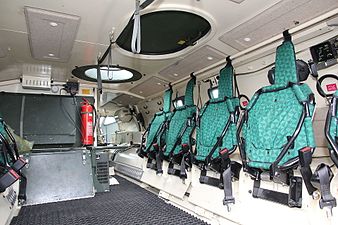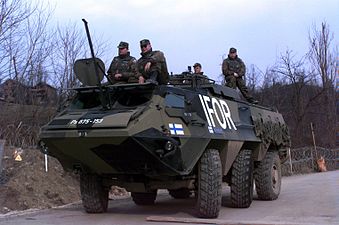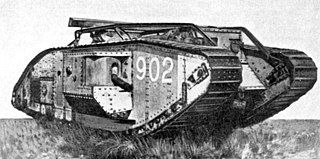
An armoured fighting vehicle (AFV) is an armed combat vehicle protected by armour, generally combining operational mobility with offensive and defensive capabilities. AFVs can be wheeled or tracked. Main battle tanks, armoured cars, armoured self-propelled guns, and armoured personnel carriers are all examples of AFVs.

The Patria AMV is an 8×8 multi-role military vehicle produced by the Finnish defence industry company Patria.
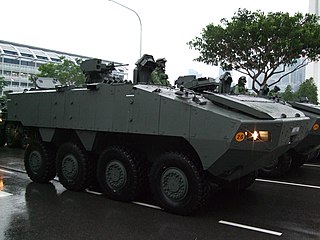
The Terrex Infantry Carrier Vehicle (ICV) is an armoured fighting vehicle (AFV) developed by ST Engineering of Singapore and produced by ST Kinetics for the Singapore Army as well as by Turkish auto-maker Otokar as the Yavuz (AV-82) for the Turkish military. The Terrex's mass is approximately 25 to 30 tonnes and the vehicle is built on an 8x8 wheeler chassis with modern military vehicle armour. Multiple-type weapon platforms are supported on the vehicle, including both remote-type weapon systems and overhead weapon stations (OWSs).

The BTR-80 is an 8×8 wheeled amphibious armoured personnel carrier (APC) designed in the USSR. It was adopted in 1986 and replaced the previous vehicles, the BTR-60 and BTR-70, in the Soviet Army. It was first deployed during the Soviet–Afghan War.
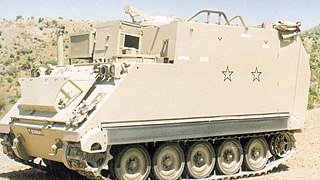
Talha is an armoured personnel carrier (APC) designed and manufactured in Pakistan by APC Factory of Heavy Industries Taxila (HIT). The vehicle is based on the M113-A2-Mk.1 APC. The Pakistan Army plans to deploy 2,000 Talha APCs by year 2010. TALHA is an all terrain, amphibious infantry support vehicle with 12.7 mm machine gun as its main armament. Adequate crew compartment space provides excellent crew comfort. Survivability is enhanced through use of external fuel tanks. Various forms of bolt-on armour can be added to increase armour protection of the vehicle.

The Nordic Battlegroup (NBG) is one of eighteen European Union battlegroups. It consists of around 2,500 soldiers including officers, with manpower contributed from the seven participating countries. The military strategic command of the force is done in cooperation with any of the suitable five Operation Headquarters framework nations at the time for deployment. Denmark has opted out of the Common Security and Defence Policy of the EU, hence all battlegroups. Norway has negotiated an opt-in to participate, even though it is not an EU member state. Sweden, Finland and Norway have planned to form a joint battlegroup.
A huge number of M113 Armored Personnel Carrier variants have been created, ranging from infantry carriers to nuclear missile carriers. The M113 armored personnel carrier has become one of the most prolific armored vehicles of the second half of the 20th century, and continues to serve with armies around the world in many roles.
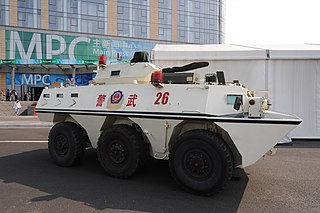
The WZ-551 is a Chinese wheeled armored personnel carrier. It is actually consisted of two families of vehicles with official designations in the People's Liberation Army as Type 90 and Type 92. Roughly 900 WZ-551s are in service with the PLA, where they are used by light mechanized infantry units. WZ-551s have been exported to Algeria, Bosnia, Sri Lanka, Nepal, Pakistan and Senegal.

The Dragoon 300 AFV was produced by Arrowpointe Corporation during the 1980s. It was based on the automotive components of the United States Army's M113 APCs and 5-ton trucks. It resembles a larger V-150 Commando.

The BOV, is an all-wheel drive armoured vehicle manufactured in the former Yugoslavia and today in Serbia. Currently in development is second generation BOV.
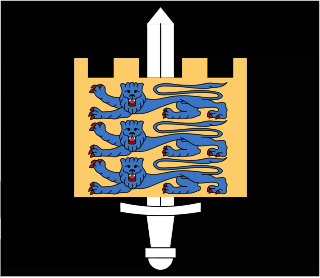
The Estonian Land Forces, unofficially referred to as the Estonian army, is the name of the unified ground forces among the Estonian Defense Forces where it has an offensive military formation role. It is currently also the largest military branch with the average size during the peacetime with around 6,000 soldiers, conscripts, and officers.

The BRDM-2 (EST) is an Estonian version of the BRDM-2, a 4x4 wheeled armored personnel carrier (APC) designed in the Soviet Union.

The Fahd is a 4x4 Egyptian armored personnel carrier, designed to fit the requirements of the Egyptian Military. It replaced older APCs in Egyptian service such as the BTR-40, and the Walid. It has been used by eight nations including Egypt, besides being used by the United Nations.

The Scouts Battalion is a battalion of the Estonian Land Forces. It is a part of the 1st Infantry Brigade and acts as its rapid response unit. The battalion is currently based at Tapa and is commanded by Lieutenant Colonel Tarmo Kundla.

The Didgori-1 is a Georgian-made armoured personnel carrier developed by the "Delta" research center of the Ministry of Defence and part of the Didgori-series APC family currently constructed in five baseline variants.
The Patria Pasi armoured personnel carrier was the choice of the Finnish Defence Forces to replace its aging Soviet BTR-60s. It was a result of the commercial competition between two Finnish companies, a tractor manufacturer Valmet and the lorry manufacturer Sisu, which won the contract with its prototype.

The Didgori-II is an armoured multi-role and special operations vehicle produced by STC DELTA. It was developed in 2009 alongside the Didgori-1 using the same internal features with some additional functions. The armoured personnel carrier is thought to provide transport, enhanced visibility and firepower support for infantry troops and SF in various missions including reconnaissance and convoy protection.
The PMPV MiSu is a Finnish made six-wheeled amphibious mine-resistant ambush protected armoured personnel carrier (APC) designed for the Finnish Defence Forces as a possible replacement for its XA-180-series vehicles. The first version was produced in 2015 and test production began in 2017. It was designed to operate with ease of use, simple structure and low-cost maintenance. The basic appearance and configuration of PMPV Misu is similar to most wheeled MRAPs. The Misu is fully amphibious.





